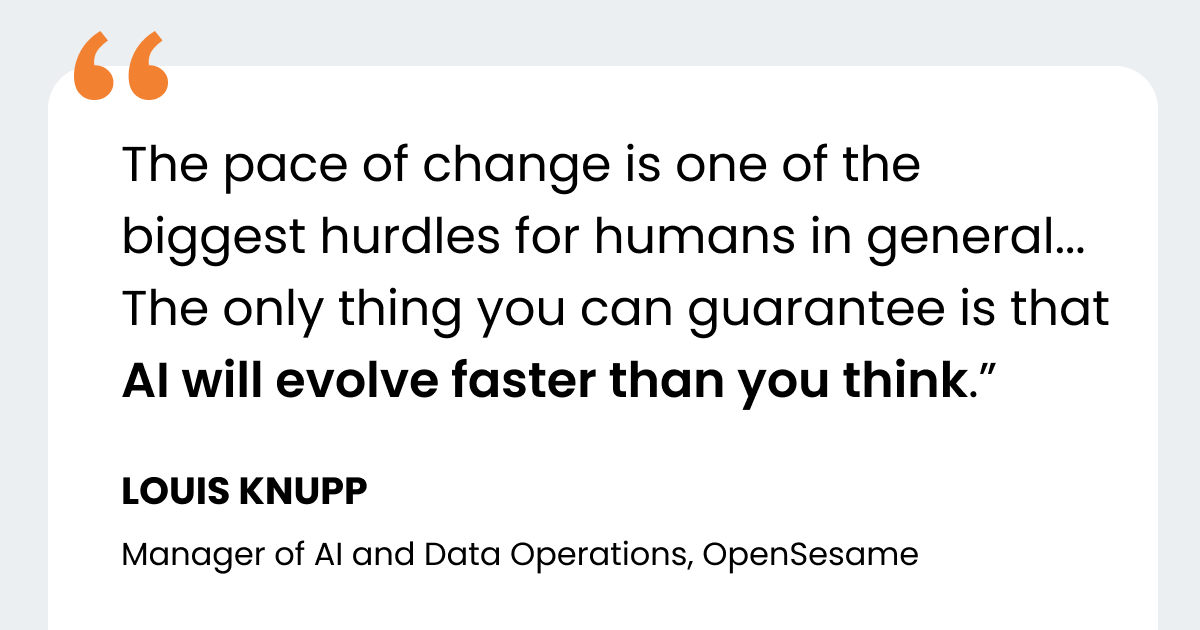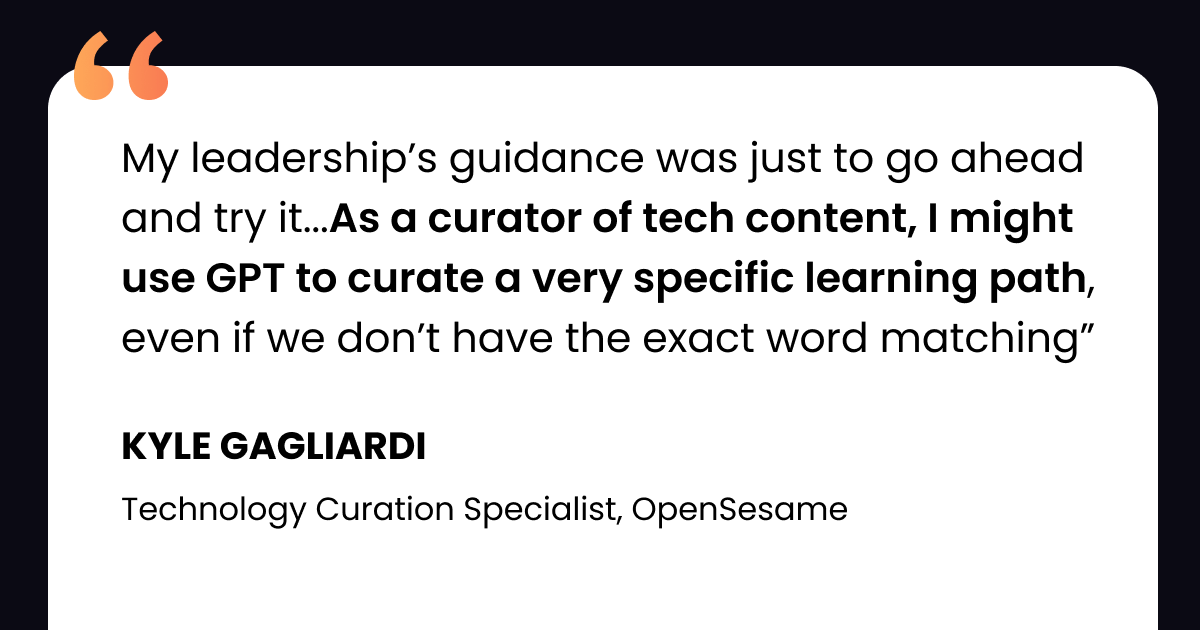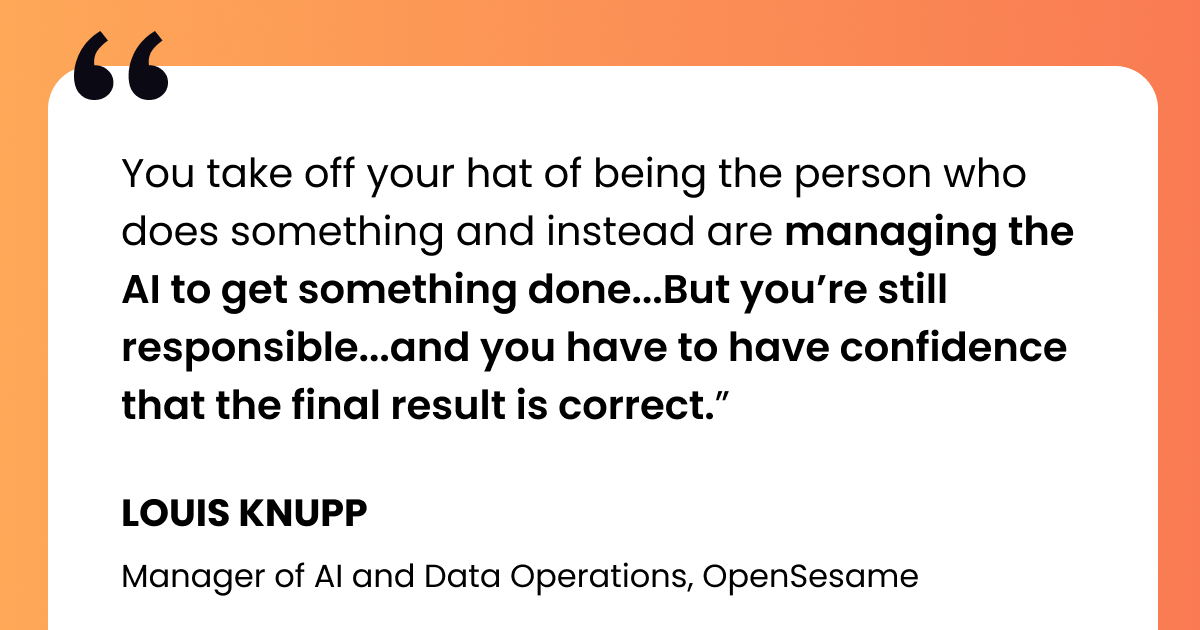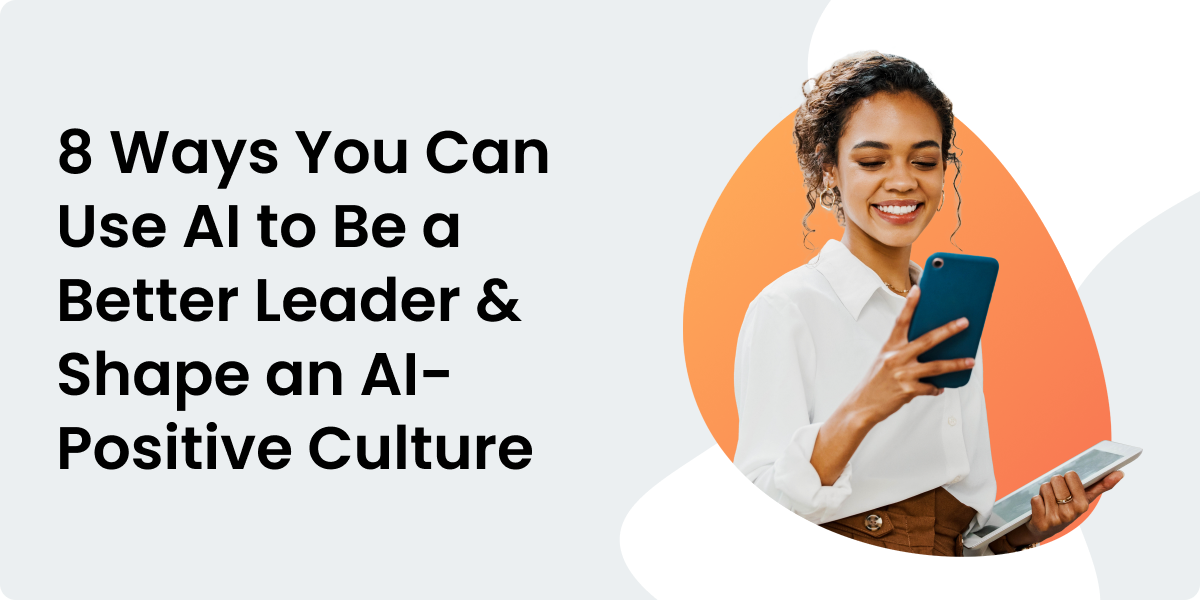We often hear from leaders eager to dive into AI but needing help figuring out where to start (and maybe already feeling a little behind or intimidated). They want practical steps to seamlessly integrate AI into their operations and show their commitment to this powerful technology. While it might feel overwhelming, any forward-thinking leader ready to learn and grow alongside their team is already ahead.
“Executives are responding to the call for AI assisting in efficiency and productivity,” said Andrew Harris, Senior Customer Success Operations Manager at OpenSesame. “The idea that a non-human entity, that doesn’t require a salary, can take up the slack is super helpful to a business model—but adoption is a long-term consideration.”
No, it’s not robots
Remember when AI felt like a distant dream? Well, it’s officially a reality we interact with daily to boost our efficiency. “The pace of change is one of the biggest hurdles for humans in general,” said Louis Knupp, Manager of AI and Data Operations at OpenSesame. “The only thing you can guarantee is that AI will evolve faster than you think.”
Tools like ChatGPT and Microsoft Copilot are here to make our lives easier by providing insights, optimizing operations, and even generating content. These are not the sci-fi robots we once imagined; this is sophisticated, usable software for everyday tasks.
What is an AI-augmented leader?
This month, Harvard Business Review published a study highlighting the benefits of being an “AI-augmented leader.” It defines this as a leader who “can leverage both the power of AI and develop their most human qualities, bringing the best of both human and machine to their leadership practice.”
Leaders with high awareness, wisdom, and compassion are well suited to step into the future by leveraging AI’s powers. They mix human touch with AI help, use context, ask the right questions, and interpret AI answers well.

Integrating AI into your culture
So, how can we, as leaders, go beyond just talking about AI and integrate it into our organizational culture? We’ve got some ideas for you, and our AI experts at OpenSesame are leading the way.
Use AI as a leader and fail publicly
Embracing AI as a leader and being open about your failures is powerful. By sharing your own successes and setbacks, you create a culture of learning and innovation. This demystifies AI, builds trust, and encourages a growth mindset.
“Innovation is about failing publicly and gleefully,” says Harris. “Ask for help. Do the things people are afraid to do first,” he adds. AI is so new, “No one knows a ton about GPT in any organization at this point. The expert in your company knows 2 percent more about AI than you. That’s it,” he points out.
He also reminds leaders that AI can be game-changing for leadership development. For managers, the GPT model with the conversational aspect is an opportunity for vulnerability and leadership growth: “I’m brutally honest about myself with AI, and I’m able to get insight, input, ideas, and perspectives that I wouldn’t have heard otherwise.”
Demystify AI processes and set up a culture of experimentation
Like any good habit, using AI takes repeated, intentional practice. Start by hosting workshops and training sessions that discuss AI in simple terms everyone can understand. Use real-life examples to show how AI can streamline everyday tasks and encourage a culture of experimentation so employees can explore AI tools relevant to their roles.
“Set up a culture where folks are set free to experiment with it,” Knupp says. But then, he adds, continuously try new things. “AI advice six months ago is irrelevant. Set people loose with some guardrails.”
Make sure you celebrate successes, learn from setbacks, and foster a mindset of ongoing learning. “My leadership’s guidance was just to go ahead and try it,” said Kyle Gagliardi, Technology Curation Specialist at OpenSesame. “As a curator of tech content, I might use GPT to curate a very specific learning path, even if we don’t have the exact word matching.”
Formal training programs should be a part of the mix—be sure to enroll yourself first. “Make sure you’re trained up,” Harris emphasizes. “Put yourself in class with everyone else.” Again, leading by example goes a long way here.

Integrate AI into daily operations
Encourage your team to use AI as a search engine. Identify tasks where AI can boost efficiency by automating routine work, analyzing data, or improving customer interactions.
Gagliardi uses it daily: “Contextual search speeds up little pieces of my job,” he says. “I can tell AI, ‘I want to curate a list of courses on topics related to external facing customer communication’ – or – ask it, ‘What’s an emerging trend people weren’t talking about last year?’”
Harris points out leaders have to “get comfortable with a tool where you’re not going to get an explicit outcome every time.” That’s because, he adds, human oversight is essential to ensure accuracy and reliability.
Highlight early adopters
To foster an AI-friendly culture, highlight the early adopters within your organization. Celebrate their successes and share their stories, showing how they’ve used AI to enhance or streamline their work.
This not only recognizes their efforts but also inspires others. It builds a culture of innovation and continuous improvement. “Find someone who has found a use case and then have them present it,” says Knupp.
Create an AI champions group
Going a step further, gather a group of enthusiastic advocates who are genuinely interested in the topic and have a basic understanding of how AI works. “You need internal champions—you can’t just have one person teaching AI,” Knupp emphasizes. “This gets people comfortable with AI and excited to share what they’ve done.”
A collective of AI evangelists can create momentum and excitement around the change, making it easier for others to get on board. Knupp adds that internal champions don’t need to be experts, but having baseline knowledge and genuine interest is crucial. Here at OpenSesame, leadership provided resources and support for our AI champions, with tools and training to make their AI impact even bigger.
And we’re seeing improvement in generative AI adoption as a result. Knupp recently interviewed people from every department and found each team had incorporated AI in their workflow, which he attributes to both the champions and ongoing AI clinics.
Use AI intentionally
There’s a temptation to apply AI to everything—don’t give in. Instead, identify where it’s most valuable. “Find out where the most time is spent,” Harris says. “Time is the biggest economy we’re trying to regain.”
Leadership should be thoughtful and check back in. “At OpenSesame we looked for increases in efficiency from when we rolled it out to now,” adds Harris. “That exercise gave us a lot of insight.”
Knupp highlights how one process that used to take the Curation team over four hours can now be completed in less than 15 minutes.

Use guardrails and be clear on AI policies
As leaders, we need to be crystal clear and open about AI policies, protecting sensitive data, and adhering to privacy regulations. Make sure your employees know exactly what you expect and how to stay compliant, and use robust security measures to safeguard information.
Most importantly, human oversight is critical for anything with an internal business or customer-facing impact. Knupp points out that he often uses AI to create code to solve real problems, but always with fact-checking measures in place.
“You take off your hat of being the person who does something and instead are managing the AI to get something done,” Knupp says. “But you’re still responsible . . . and you have to have confidence that the final result is correct.”
To ensure we all understood OpenSesame’s AI approach, we were all assigned a short course on official policy with a mandatory knowledge check.
Track progress with surveys
Like any new tool, to successfully adopt AI in your organization, check back in. Use surveys to gauge your employees’ current knowledge and attitudes toward AI. Then, use the results to tailor your training programs and address specific concerns, making the transition smoother.
By involving your team in this process, you show their input is valued. “At OpenSesame, we make sure what we put out there is working so people don’t reject it entirely,” Harris says. “If it doesn’t actually provide value, then critical adoption won’t continue.”
Take the leap
As leaders, we can take proactive steps to create an AI-positive culture. It means equipping our teams with the right tools and knowledge, fostering a supportive environment, and prioritizing transparency and ethics. And, while AI is beneficial, it’s never a silver bullet. “AI is a great place to start, but you still need a great human touch to get it there,” Gagliardi notes. When used intentionally and responsibly, it can be a real game changer for your business.
Are you trying to build better leaders at your organization? Our Leadership Development toolkit has all the pieces you need—including free courses—to take this training initiative to the next level.
Or, if you’re looking for training on using AI across your business, check out our course list curated by our technology expert, Kyle Gagliardi, to start growing those AI skills.
